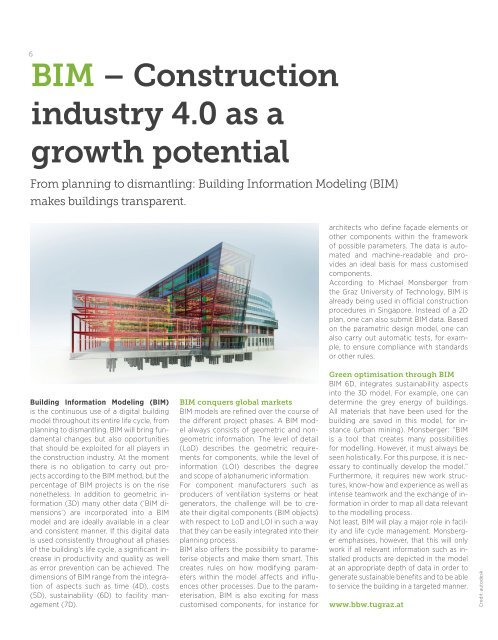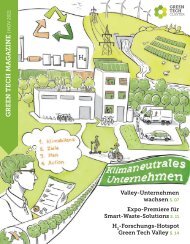Green Tech Magazine December 2017 en
You also want an ePaper? Increase the reach of your titles
YUMPU automatically turns print PDFs into web optimized ePapers that Google loves.
6<br />
BIM – Construction<br />
industry 4.0 as a<br />
growth pot<strong>en</strong>tial<br />
From planning to dismantling: Building Information Modeling (BIM)<br />
makes buildings transpar<strong>en</strong>t.<br />
architects who define façade elem<strong>en</strong>ts or<br />
other compon<strong>en</strong>ts within the framework<br />
of possible parameters. The data is automated<br />
and machine-readable and provides<br />
an ideal basis for mass customised<br />
compon<strong>en</strong>ts.<br />
According to Michael Monsberger from<br />
the Graz University of <strong>Tech</strong>nology, BIM is<br />
already being used in official construction<br />
procedures in Singapore. Instead of a 2D<br />
plan, one can also submit BIM data. Based<br />
on the parametric design model, one can<br />
also carry out automatic tests, for example,<br />
to <strong>en</strong>sure compliance with standards<br />
or other rules.<br />
Building Information Modeling (BIM)<br />
is the continuous use of a digital building<br />
model throughout its <strong>en</strong>tire life cycle, from<br />
planning to dismantling. BIM will bring fundam<strong>en</strong>tal<br />
changes but also opportunities<br />
that should be exploited for all players in<br />
the construction industry. At the mom<strong>en</strong>t<br />
there is no obligation to carry out projects<br />
according to the BIM method, but the<br />
perc<strong>en</strong>tage of BIM projects is on the rise<br />
nonetheless. In addition to geometric information<br />
(3D) many other data (‘BIM dim<strong>en</strong>sions’)<br />
are incorporated into a BIM<br />
model and are ideally available in a clear<br />
and consist<strong>en</strong>t manner. If this digital data<br />
is used consist<strong>en</strong>tly throughout all phases<br />
of the building‘s life cycle, a significant increase<br />
in productivity and quality as well<br />
as error prev<strong>en</strong>tion can be achieved. The<br />
dim<strong>en</strong>sions of BIM range from the integration<br />
of aspects such as time (4D), costs<br />
(5D), sustainability (6D) to facility managem<strong>en</strong>t<br />
(7D).<br />
BIM conquers global markets<br />
BIM models are refined over the course of<br />
the differ<strong>en</strong>t project phases. A BIM model<br />
always consists of geometric and nongeometric<br />
information. The level of detail<br />
(LoD) describes the geometric requirem<strong>en</strong>ts<br />
for compon<strong>en</strong>ts, while the level of<br />
information (LOI) describes the degree<br />
and scope of alphanumeric information.<br />
For compon<strong>en</strong>t manufacturers such as<br />
producers of v<strong>en</strong>tilation systems or heat<br />
g<strong>en</strong>erators, the chall<strong>en</strong>ge will be to create<br />
their digital compon<strong>en</strong>ts (BIM objects)<br />
with respect to LoD and LOI in such a way<br />
that they can be easily integrated into their<br />
planning process.<br />
BIM also offers the possibility to parameterise<br />
objects and make them smart. This<br />
creates rules on how modifying parameters<br />
within the model affects and influ<strong>en</strong>ces<br />
other processes. Due to the parameterisation,<br />
BIM is also exciting for mass<br />
customised compon<strong>en</strong>ts, for instance for<br />
<strong>Gre<strong>en</strong></strong> optimisation through BIM<br />
BIM 6D, integrates sustainability aspects<br />
into the 3D model. For example, one can<br />
determine the grey <strong>en</strong>ergy of buildings.<br />
All materials that have be<strong>en</strong> used for the<br />
building are saved in this model, for instance<br />
(urban mining). Monsberger: “BIM<br />
is a tool that creates many possibilities<br />
for modelling. However, it must always be<br />
se<strong>en</strong> holistically. For this purpose, it is necessary<br />
to continually develop the model.”<br />
Furthermore, it requires new work structures,<br />
know-how and experi<strong>en</strong>ce as well as<br />
int<strong>en</strong>se teamwork and the exchange of information<br />
in order to map all data relevant<br />
to the modelling process.<br />
Not least, BIM will play a major role in facility<br />
and life cycle managem<strong>en</strong>t. Monsberger<br />
emphasises, however, that this will only<br />
work if all relevant information such as installed<br />
products are depicted in the model<br />
at an appropriate depth of data in order to<br />
g<strong>en</strong>erate sustainable b<strong>en</strong>efits and to be able<br />
to service the building in a targeted manner.<br />
www.bbw.tugraz.at<br />
Credit: autodesk


















